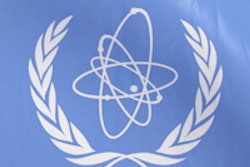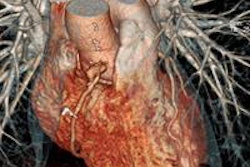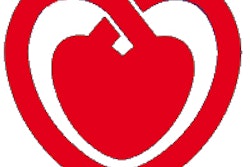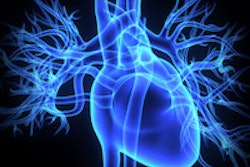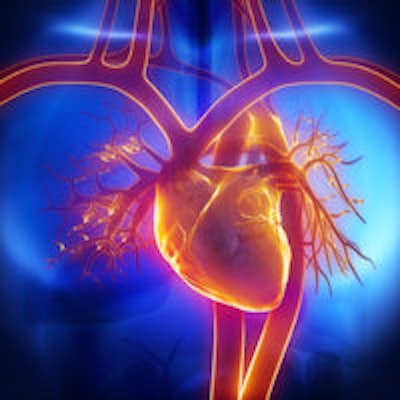
Radiation doses for myocardial perfusion imaging (MPI) exams in the U.S. are significantly higher than those in the rest of the world. Few U.S. sites adhere to best practices for dose reduction, and the U.S. fee-for-service model also contributes to the disparity, according to articles published online December 28 in JAMA Internal Medicine.
The International Atomic Energy Agency (IAEA) Nuclear Cardiology Protocols Cross-Sectional Study (INCAPS) examined radiation dose from almost 8,000 patients from 138 laboratories and 65 countries. U.S. doses for the test were found to be 20% higher, with a mean U.S. radiation dose of 11.6 mSv versus 9.7 mSv in the rest of the world (p < 0.001).
"The U.S. INCAPS study not only determined that radiation doses for myocardial perfusion imaging are higher in the U.S. than in the rest of the world, but more importantly identified potential opportunities for improvement that will enable us to work at correcting this disparity," wrote senior author Dr. Andrew Einstein, PhD, from Columbia University Medical Center in New York City, in an email to AuntMinnie.com.
Looking at worldwide dose
INCAPS is the first comprehensive study to look at radiation doses from nuclear cardiology exams on a worldwide basis. The U.S. arm of the study included 50 sites in 22 states from all U.S. regions; it gathered comprehensive data on patients undergoing MPI during a one-week period in 2013, yielding 1,902 U.S. patients out of 7,911 patients worldwide.
Median and mean patient and laboratory radiation doses were compared, along with quality index scores. The researchers tallied the proportion of sites that adhered to each of eight best practices for keeping radiation dose low, the percentage that adhered to six or more best practices, and those that achieved a median dose level of 9 mSv or less (JAMA IM, December 28, 2015).
An IAEA panel identified the eight best practices:
- Avoiding thallium stress testing in patients 70 years or younger, as thallium has a long half-life (three days) and exposes patients to more radiation than technetium-99m (Tc-99m).
- Avoiding the use of both thallium and Tc-99m protocols in nonelderly patients.
- Being judicious in the use of Tc-99m.
- Avoiding too much thallium.
- Performing stress-only imaging, when possible, rather than requiring every patient to undergo rest and stress tests.
- Using gamma camera-based dose-reduction strategies, including advanced hardware and software, or prone and supine imaging to reduce false positives.
- Applying weight-based dosing for Tc-99m to minimize isotope use.
- Avoiding imaging practices that produce residual counts from the first injection that interfere with the second scan.
Higher doses
The U.S. radiation dose for MPI was higher (median, 11.6 mSv) than the dose used in the rest of the world (median, 9.7 mSv; p < 0.001), with a dose range of 3.5 mSv to 24.5 mSv among U.S. sites.
Moreover, only 24.4% of U.S. patients had a dose at the target of 9 mSv or less, compared with 32.6% at non-U.S. labs (p < 0.001), Einstein and colleagues wrote. Adherence to best practices was lower in U.S. laboratories, as reflected by the lower mean quality index of 4.6 versus 5.6 for the rest of the world (p < 0.001).
U.S. laboratories outperformed non-U.S. facilities in avoiding thallium stress in younger patients, but they underperformed in four of the other seven quality practices. Demographics also favored the non-U.S. population. Americans were older with a higher proportion of women, compared with non-U.S. patients.
Finally, dose-reduction practices such as weight-based dosing (16% U.S. versus 31% in the rest of the world), careful technetium use (56% versus 91.1%), and implementation of stress-only protocols in some patients were adopted significantly less often in U.S. facilities. The use of stress-only protocols cut the radiation dose by a mean of 63.6% worldwide.
| Radiation dose for MPI exams by global region | |||
| U.S. | Europe | Worldwide | |
| Median effective dose (nonstress only) | 11.6 mSv | 9.4 mSv | 9.7 mSv |
| Percentage of patients with median radiation dose < 9 mSv | 14% | -- | 32.6% |
| Percentage of patients undergoing stress-only imaging | 3.1% | 19.8% | 11.9% |
| Quality index score ≥ 6 | 30% | -- | 49.2% (p < 0.01) |
Differences vs. Europe
The INCAPS study found better use of best practices and lower radiation doses in Europe compared to the rest of the world, Einstein wrote in his email.
"But even within Europe, there is considerable variation and opportunities to improve practice -- for example, in Eastern and Southern Europe, where only a minority of laboratories performed stress-only imaging, and in Eastern and Western Europe, where only a third of laboratories tailored dosing to a patient's weight," he said. "There is little use of cardiac PET in Europe [about 2%], and that is an opportunity to improve throughout the continent."
In an accompanying editorial, Dr. Rebecca Smith-Bindman and Dr. Andrew Bindman, both from the University of California, San Francisco, called the fee-for-service reimbursement model in the U.S. an important cause of the overuse of MPI exams.
"Overuse and misuse of imaging tests are ... predictable symptoms of a fee-for-service payment system that incentivizes volume over value," they wrote. "To change the rate of use and the radiation doses associated with imaging tests, we must realign the incentives in our fee-for-service system to reward quality rather than quantity."
Recognizing the shortcomings of a fee-for-service system, Congress has created the Merit-Based Incentive Payment System (MIPS), "which will soon place Medicare physicians at financial risk for their practice style," they wrote. A variety of new vehicles, including accountable care organizations (ACOs), are designed to accomplish this goal.
The development of quality and performance measures, the mandatory use of appropriateness criteria, and increased adherence to reduced-dose criteria such as Choosing Wisely will also contribute to improvements in this area, they added.
"The establishment of meaningful measures of performance in combination with payment reform offers the best hope of improving the value and safety of medical imaging studies," they wrote.
In his email, Einstein offered several ideas as well.
"For starters, we should perform much more stress-first imaging," he said. "Stress-first imaging occurred in 84% of European patients versus 8% in the U.S. If stress imaging is not performed before rest imaging, it's impossible to do stress-only imaging. Additionally, there is a financial penalty paid to perform stress-only imaging, despite the equivalent diagnostic and prognostic information that it provides."
The U.S. Centers for Medicare and Medicaid Services (CMS) needs to reconsider reimbursement, he noted. In some cases, stress-only imaging doesn't get reimbursed at all.
"We need to eliminate such a situation," Einstein said.
What best practices aren't being used by U.S. sites? Another research letter by Mathew Mercuri, PhD, Einstein, and colleagues noted that several steps, such as careful attention to isotope use and increased use of stress-only imaging, can reduce radiation dose by well over half in the majority of patients who do not require stress and rest studies. However, the reduced cost and radiation dose of a stress-only test carries a high price for providers -- $137 less in reimbursement.
"Our findings suggest a clear need for change in the U.S. to achieve parity with worldwide practice in the use of stress-only imaging, and thereby reduce the radiation burden from MPI," they wrote.




